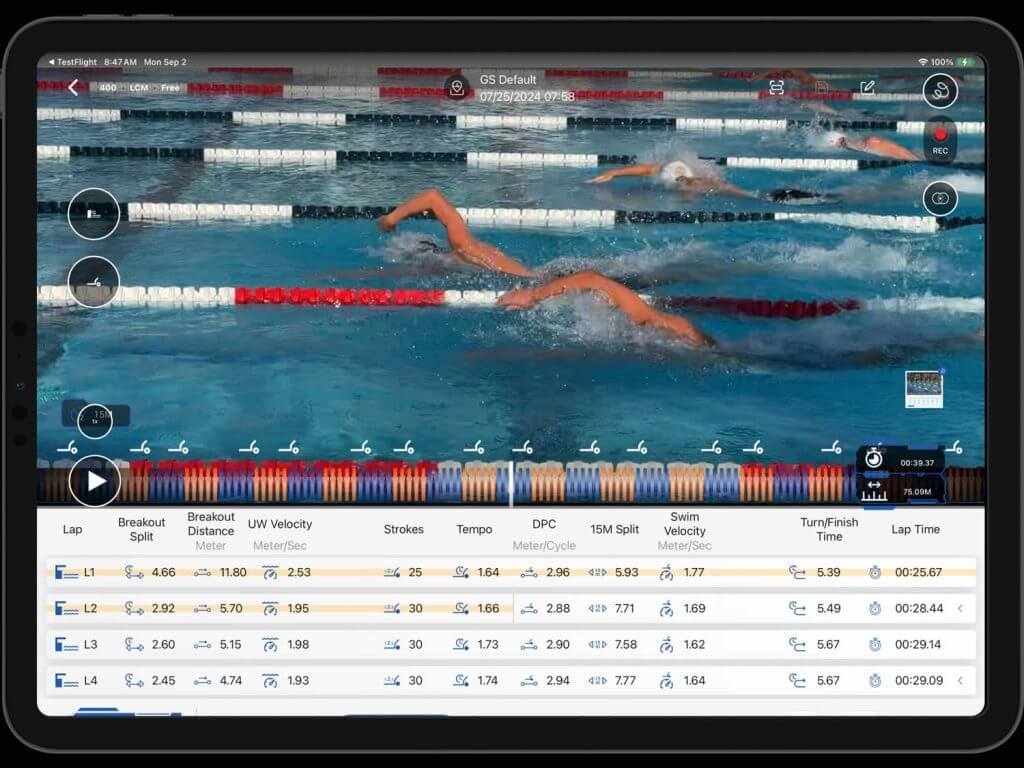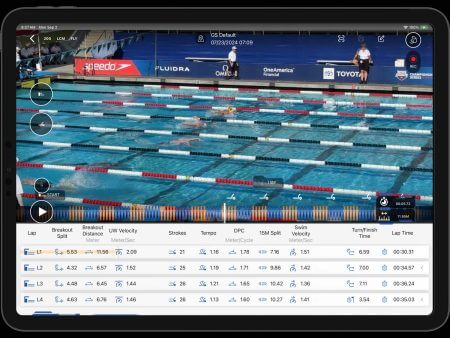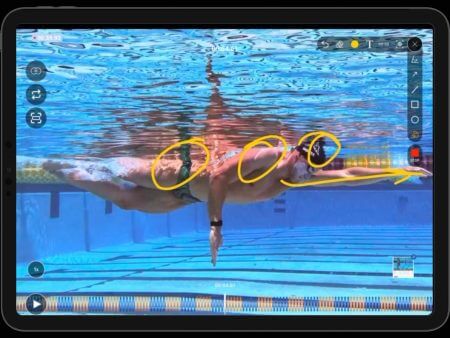GoSwim Launches App Designed to Provide Data-Centric Video Feedback For Swimmers

GoSwim Launches App Designed to Provide Data-Centric Video Feedback For Swimmers
For almost two decades, GoSwim has provided videos aimed at helping swimmers improve, with world-class competitors demonstrating skills and drills for a vast audience, as well as other content involving swimming education. Now, with the company’s library of content numbering around 3500, co-founder and 1980 U.S. Olympian Glenn Mills has rolled out his next innovative idea, a smartphone application designed to bring specific and personalized feedback for swimmers of all levels.
At swim meets around the world each weekend, parents record their children swimming on their phones. Seems innocuous enough, but these videos might be shown to a swimmer once, then lost forever within the depths of the parent’s phone memory. With the new GoSwim app, the coach is brought back into the loop, and even low-quality videos marred by obtrusions such as lifeguard stands and random passersby can become effective and powerful long-term teaching tools.
The race video can be filmed through the app or through another smartphone camera and then imported. During filming (if using the app) or afterward, a swimmer or coach will mark up the swim by clicking the “stroke” button with every cycle, the “turn” button at the end of every lap and the “finish” button at the end of the race. After that, a user can click the clipboard icon in the lower righthand corner to see a large collection of data, including breakout split, breakout distance, underwater velocity, stroke length, stroke rate, distance per cycle, 15-meter splits, turn time and lap time.
“Through the entire race, you can see what happens to somebody’s stroke length or stroke length as they fatigue,” Mills said. “If they negative split a race, you can watch how they’re doing that.”

Race analysis in the new GoSwim app
If a swim is recorded directly through the app, the videographer can categorize the race by stroke, distance and course. If a parent is filming the race, the video can be shared with the swimmer or coach through the app, and after a swimmer warms down, the coach can show the race video on an iPad while debriefing with the swimmer. The coach can add verbal commentary to the video and use annotation tool to point out areas for reinforcement and refinement.
Then, the coach can pull up a list of athletes and tap the appropriate name, instantly sharing the video with a swimmer.
“We’ve tried to create technology where coaches don’t have to learn, and they don’t have to spend any time uploading or downloading,” Mills said. “Everything just happens automatically. We have your full markup capability that you can make comments and add some critique to the video.”
Mills hopes that use of this new feedback app can help normalize the use of data in swimming and engage swimmers with these aspects that can be critical for improvement. The app will be in use this season with the Northwestern swimming program, for which Rachel Stratton-Mills, Glenn’s wife, is the second-year head coach. Stratton-Mills’ swimmers will be sent their race videos through the app, and then they will add in their stroke and turn data individually.
“This increases their engagement in the process,” Mills said. “As the swimmers are adding the data, they’re re-watching the race. They’re now engaged with their stroke rate, stroke length, breakout point, underwater velocity, above-water velocity.”
And athletes far beyond the Division I level can benefit. Mills believes swimmers as young as 10 and 11 can benefit from adding in their data and engaging with the process of race analysis. Using the app, a coach can gamify the process of providing feedback.
“If you want to teach someone a new language, when is it best to do? When they’re young or when they’re old? We’re teaching the language of stroke rate, stroke length, breakout point,” Mills said. “When those 11-year-olds are 14-year-olds, they’re going to know so much that by the time the coach talks to them, they’re going to know why they’re supposed to do things.”
During the development of the app, Mills and GoSwim have taken extensive precautions to ensure privacy and protection of the minor swimmers whose video likeness will be shared using the system. Mills has met with numerous agencies, including USA Swimming Safe Sport, and worked with privacy attorneys to ensure the app follows all laws, regulations and compliance issues.
To receive their race videos, every swimmer has to own their own GoSwim account to ensure that another adult (i.e., a parent) is involved in the data transfer, as required by law. The GoSwim system stores a temporary copy of video content within a phone, but the app offers a one-click removal of all synched videos from the device. But the videos are still accessible for eternity thanks to unlimited storage provided by Amazon Web Services (AWS).
“We had to design our technology as if the worst person in humanity was trying to use it,” Mills said. “That’s why a parent has to be included. Every share that goes out, a parent gets a copy of it.”

The GoSwim app markup tool in action
Coaches can purchase GoSwim accounts for $124.99 per year, and with that purchase, they can invite swimmers to join with free accounts and share videos from the GoSwim library. To utilize the video feedback tool and receive shared videos, swimmers must upgrade to paid accounts costing $99.99 per year. GoSwim offers significant discounts to teams and coaches who they work with.
Some teams have required purchase of the GoSwim app with team registration but insisted that families make the purchase on their own, with GoSwim required to have a credit card on file to ensure that a non-minor family member is looped into coach-swimmer communications. In another instance, a masters coach did not require swimmers to purchase the GoSwim app but offered to film and send race video to anyone who did.
The process of developing the app has taken years and included significant hurdles along the way, but now that it has reached the market, Mills believes the product is capable of providing a boost to swimmers around the world, with the app likely to improve as his team works out any initial issues users encounter.
“It has taken us a long time to get to this point, and it’s been a lot of work. I’m not a big fan of things that I do. I’m proud of this. I’m really proud of it, and I think we’ve done a good job,” Mills said. “I’m very critical of myself. I’ve always been very critical. It’s what made me a good swimmer. You’re always striving to do something better, and you’re very rarely satisfied with what you done. This I’m very proud of.”




Glenn, you should be proud. What you have done is one of the most significant breakthroughs in swimming and race analysis I have seen. The simplicity of it is masterful. The amount of information made available to swimmers and coaches is fantastic. Congratulations. What a useful tool you have made available to the swimming community.
Ernie. You were certainly a big part starting my journey. From the stroke film so many years ago that you put me on, to the volumes of information in your books. The countless people that have learned from you, what an honor for you to appreciate the work we put into this project. Thank you so much and look forward to talking soon. Glenn